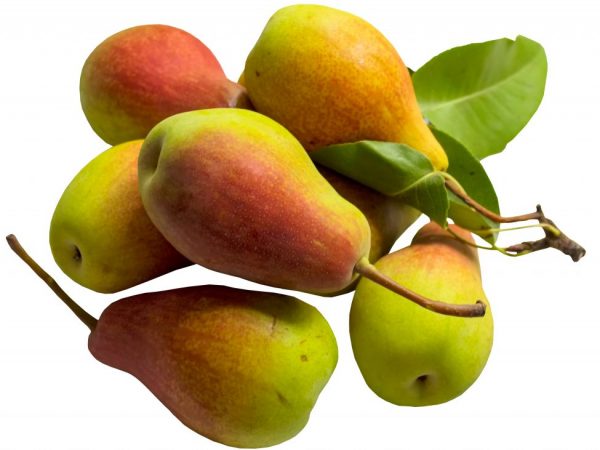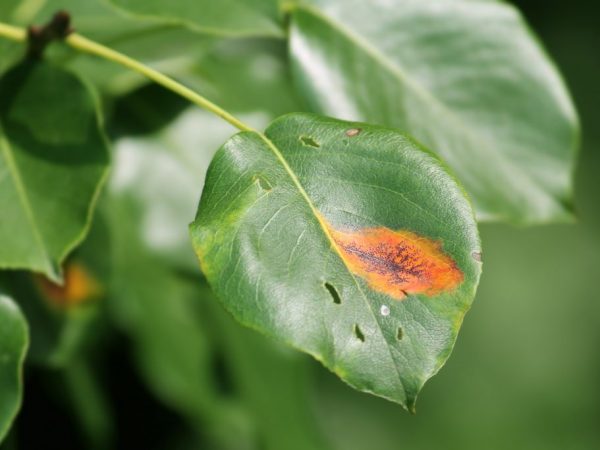Characteristics of the pear variety Russian Krasavitsa
Sweet pear Russian beauty has another name - Beauty Chernenko. This autumn pear has earned its popularity due to its easy care and unique fruit flavor.

Characteristics of the pear variety Russian Krasavitsa
Characteristics of the variety
Pear Russian beauty has a good characteristic. The crop can be stored for a month and a half. The garden pear variety Russkaya Krasavitsa (Chernenko) can be grown for industrial use. Juices and preserves are made from the fruits of this tree, and they are also used in winemaking.
Description of the tree
The description shows that the tree is medium-sized, reaching a height of 5 meters. The volume of the trunk is 2.5 meters. The branches grow upward. Shoots are medium in size and have nap on them. After planting the seedling, you will have to wait for the fruits for 8 years. Leaves are small and elongated with small notches. The leaf color is light green. Flowers that grow with large white petals. The winter season does not scare this variety, as it is resistant to cold.
Description of fruits
The fruits are very large. Fruit weight on average 150-200 gr. Outwardly, the Krasavitsa Chernenko pear looks like the fruits of the varieties Lyubimitsa Yakovleva and Moskovskaya Severnaya, but only of an elongated shape. The rind is medium in density and thickness. The color changes with maturity. When removable maturity sets in, the fruit is green and with a slight blush. During consumer maturity, the fruit becomes green-yellow in color with a distinct and large blush.
Taste qualities of the variety:
- sweet and sour aftertaste
- juicy, soft, white pulp.
The fruits can be eaten both fresh and processed.

The fruits are large. Fruit weight on average 150-200 gr
Care
Let's analyze the basic requirements for crop care.
Soil preparation and planting
According to the description, autumn is the best time to plant this variety. Before burying the seedling, you need to prepare high quality soil. The entire site must be dug up, in the process, weeds, residues from other plants and any debris must be removed. After, you need to prepare the landing pit. It is recommended to fertilize it with mineral fertilizers (two glasses of mineral fertilizer per 1 liter of water). Now you can start planting a seedling. You need to plant so that the upper part of the root looks out from the ground. When the tree has been planted, almost all of the leaves should be cut off. After that, you need to water the soil so that it becomes moist.
Care after landing
Leaving after planting is the longest step. The tree requires weekly watering. The amount of water needed for irrigation increases with the growth of the tree. You need to fertilize the plant. The plant should be fed 3 times a month. It is recommended to use mullein or urea as fertilizer (25 grams of mullein or urea per 1 liter of water). Leaves should be trimmed in early spring to attract pollinators.
Diseases and pests
Diseases
Consider the main diseases and how to deal with them.
- Pear scab. The disease appears due to fungal spores.The disease causes the appearance of light spots on the leaves. Holes appear on the fetus in which suppuration occurs. Water with the addition of fugicides (20 grams of fungicide per 1 liter of water) will help in treating the disease. Spray the plant with this solution.
- Fruit rot. The disease appears due to the spores of the fungus Monillosis. This disease causes a loss of taste in the fruit, they become covered with fungal growths and fall off. For treatment, you need to remove diseased fruits and treat the tree with a solution of milk of lime and water (100 grams of milk of lime per 1 liter of water).
- Sooty fungus. The disease causes blackening of the leaves. This is a fungal disease. Best of all, the Calypso insecticide will cope with this disease.
- Black pear cancer. This disease affects the very stem of the plant. Dark spots appear on it and it cracks leaving holes. The holes formed will rot. To cure a tree from black cancer, you need to remove the infected parts of the bark and treat the cracks with copper sulfate. The crack should be covered with a mixture of clay and mullein.
- Cytosporosis. Cytosporosis appears due to the fungus Cytospor. The bark is covered with brown ulcers in the affected areas. Usually, the disease appears if a sunburn or a sharp temperature drop has been produced. For treatment, it is necessary to cut off the diseased part of the bark, process the incision with copper sulfate and glue it with clay with a mullein.
It is important to identify the first symptoms of the disease in order to make a diagnosis and begin treatment. It is recommended to inspect all plants on the site to notice any manifestations of the disease.
If the disease has spread much, and the plant has been damaged enough, it is necessary to get rid of the plant.

It is important to identify the first symptoms of the disease in order to make a diagnosis and start treatment.
Pests
The appearance of harmful insects is a natural phenomenon, since plants are food for them and a place for laying eggs. List of possible pests of trees of this variety:
- Leafy gall midge. The leaf gall midge is a winged insect that looks like a very small mosquito. This insect can fly over fairly long distances. The very danger is caused by their stage of reproduction, because it is the larvae of the leaf gall midge that harm the plant. These larvae eat the leaves of the tree. As a result, the leaves crumble, turn yellow, become lethargic. To combat them, you need to spray the tree with insecticides.
- Medianitsa. Medianitsa is a winged insect, yellow in color and small in size. Outwardly it resembles a grasshopper. This parasite lays its eggs on the buds of the plant. Larvae appear along with bud break. The larvae eat the opened buds. Their activity spoils the fruits, because of them leaves fall, and the development of buds stops. It is necessary to hatch the larvae of Medianitsa with insecticides.
- Fruit gall midge. An insect that looks like a large mosquito in appearance. She leaves her larvae in the soil. The activity of their larvae spoils the fruit, leaves growths. It is best to use insecticides to remove this pest.
- Fruit moth. The moth is a butterfly-like insect, dark gray in color with dark spots. This parasite lays its eggs in the topsoil. Caterpillars that emerge from eggs penetrate and feed on fruits. To defeat this pest, you need to dig the soil near the tree and treat everything with insecticides.
- Gall mite. Gall mite is a very small and red mite. It feeds on leaves, lays eggs in the buds. After it, the leaves acquire brown ulcers and fall off. The recommended remedy for the fight is a solution of colloidal sulfur and water (a tablespoon of colloidal sulfur per 1 liter of water).
Pests can spread to neighboring plants. If you find them on a tree, inspect the nearby plantings.
Insects multiply rapidly. It is important to notice and start fighting from the moment they appear.
Conclusion
The pear variety Russian Beauty is the focus of many gardeners, both experienced and novice. Consumers will appreciate the high taste and versatility of cooking.


